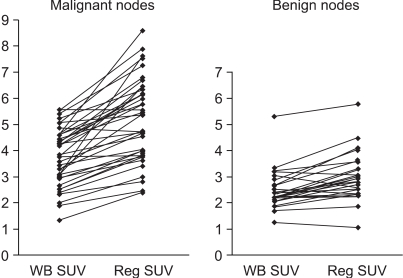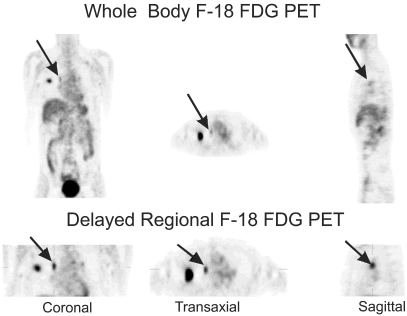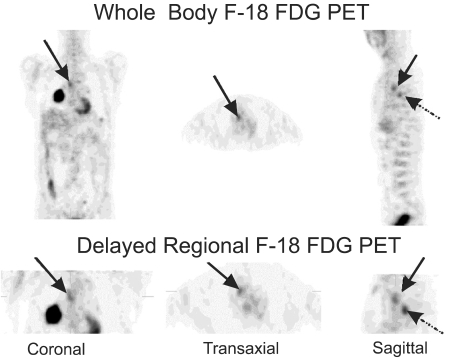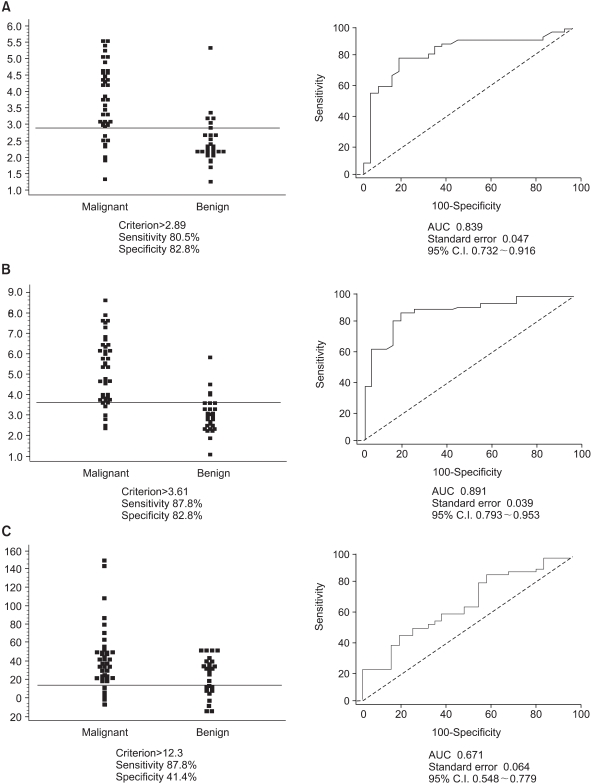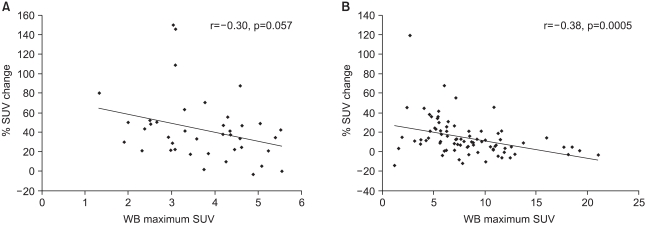Cancer Res Treat.
2005 Apr;37(2):114-121.
Usefulness of Additional Delayed Regional F-18 Fluorodeoxyglucose Positron Emission Tomography in the Lymph Node Staging of Non-Small Cell Lung Cancer Patients
- Affiliations
-
- 1Department of Nuclear Medicine and Thoracic Surgery, Seoul National University College of Medicine, Seoul, Korea. jkchung@plaza.snu.ac.kr
Abstract
- PURPOSE
In this study, we examined whether additional, delayed regional FDG PET scans could increase the accuracy of the lymph node staging of NSCLC patients. MATERIALS AND METHODS: Among 87 patients who underwent open thoracotomy or mediastinoscopic biopsy under the suspicion of NSCLC, 35 (32 NSCLC and 3 infectious diseases) who had visible lymph nodes on both preoperative whole body scan and regional FDG PET scan were included. The following 3 calculations were made for each biopsy-proven, visible lymph node: maximum SUV of whole body scan (WB SUV), maximum SUV of delayed chest regional scan (Reg SUV), and the percent change of SUV between WB and regional scans (% SUV Change). ROC curve analyses were performed for WB SUVs, Reg SUVs and % SUV Changes. RESULTS: Seventy lymph nodes (29 benign, 41 malignant) were visible on both preoperative whole bodyscan and regional scan. The means of WB SUVs, Reg SUVs and % SUV Changes of the 41 malignant nodes, 3.71+/-1.08, 5.18+/-1.60, and 42.59+/-33.41%, respectively, were all significantly higher than those of the 29 benign nodes, 2.45+/-0.73, 3.00+/-0.89, and 22.71+/-20.17%, respectively. ROC curve analysis gave sensitivity and specificity values of 80.5% and 82.8% at a cutoff of 2.89 (AUC 0.839) for WB SUVs, 87.8% and 82.8% at a cutoff of 3.61 (AUC 0.891) for Reg SUVs, and 87.8% and 41.4% at a cutoff of 12.3% (AUC 0.671) for % SUV Changes. CONCLUSION: Additional, delayed regional FDG PET scans may improve the accuracy of lymph node staging of whole body FDG PET scan by providing additional criteria of Reg SUV and % SUV Change.
MeSH Terms
Figure
Reference
-
1. Hagge RJ, Wong TZ, Coleman RE. Positron emission tomography: brain tumors and lung cancer. Radiol Clin North Am. 2001; 39:871–881. PMID: 11587059.2. Seltzer MA, Yap CS, Silverman DH, Meta J, Schiepers C, Phelps ME, et al. The impact of PET on management of lung cancer: the referring physician's perspective. J Nucl Med. 2002; 43:752–756. PMID: 12050318.3. Hoh CK, Hawkins RA, Glaspy JA, Dahlbom M, Tse NY, Hoffman EJ, et al. Cancer detection with whole-body PET using 2-[18F]Fluoro-2-deoxy-D-glucose. J Comput Assist Tomogr. 1993; 17:582–589. PMID: 8331230.4. Lowe VJ, DeLong DM, Hoffman JM, Coleman RE. Optimum scanning protocol for FDG-PET evaluation of pulmonary malignancy. J Nucl Med. 1995; 36:883–887. PMID: 7738668.5. Fischman AJ, Alpert NM. FDG-PET in oncology: there's more to it than looking at pictures. J Nucl Med. 1993; 34:6–11. PMID: 8418272.6. Hamberg LM, Hunter GJ, Alpert NM, Choi NC, Babich JW, Fischman AJ. The dose uptake ratio as an index of glucose metabolism: useful parameter or oversimplification? J Nucl Med. 1994; 35:1308–1312. PMID: 8046485.7. Lodge MA, Lucas JD, Marsden PK, Cronin BF, ODoherty MJ, Smith MA. A PET study of 18FDG uptake in soft tissue masses. Eur J Nucl Med. 1999; 26:22–30. PMID: 9933658.8. Boerner AR, Weckesser M, Herzog H, Schmitz T, Audretsch W, Nitz U, et al. Optimal scan time for fluorine-18 fluorodeoxyglucose positron emission tomography in breast cancer. Eur J Nucl Med. 1999; 26:226–230. PMID: 10079312.
Article9. Hustinx R, Smith RJ, Benard F, Rosenthal DI, Machtay M, Farber LA, et al. Dual time point fluorine-18 fluorodeoxyglucose positron emission tomography: a potential method to differentiate malignancy from inflammation and normal tissue in the head and neck. Eur J Nucl Med. 1999; 26:1345–1348. PMID: 10541835.
Article10. Zhuang H, Pourdehnad M, Lambright ES, Yamamoto AJ, Lanuti M, Li P, et al. Dual time point 18F-FDG PET imaging for differentiating malignant from inflammatory processes. J Nucl Med. 2001; 42:1412–1417. PMID: 11535734.11. Matthies A, Hickeson M, Cuchiara A, Alavi A. Dual time point 18F-FDG PET for the evaluation of pulmonary nodules. J Nucl Med. 2002; 43:871–875. PMID: 12097455.12. Kubota R, Kubota K, Yamada S, Tada M, Ido T, Tamahashi N. Microautoradiographic study for the differentiation of intratumoral macrophages, granulation tissues and cancer cells by the dynamics of fluorine-18-fluorodeoxyglucose uptake. J Nucl Med. 1994; 35:104–112. PMID: 8271030.13. Mountain CF, Dresler CM. Regional lymph node classification for lung cancer staging. Chest. 1997; 111:1718–1723. PMID: 9187199.
Article14. National Electrical manufacturers Association. NEMA Standards Publication NU2-1994. 1994. Washington DC: National Electrical Manufacturers Association.15. Reivich M, Alavi A, Wolf A, Fowler J, Russell J, Arnett C, et al. Glucose metabolic rate kinetic model parameter determination in humans: the lumped constants and rate constants for [18F]fluorodeoxyglucose and [11C]deoxyglucose. J Cereb Blood Flow Metab. 1985; 5:179–192. PMID: 3988820.16. Nolop KB, Rhodes CG, Brudin LH, Beaney RP, Krausz T, Jones T, et al. Glucose utilization in vivo by human pulmonary neoplasms. Cancer. 1987; 60:2682–2689. PMID: 3499969.17. Kubota K, Itoh M, Ozaki K, Ono S, Tashiro M, Yamaguchi K, et al. Advantage of delayed whole-body FDG-PET imaging for tumour detection. Eur J Nucl Med. 2001; 28:696–703. PMID: 11440029.
Article18. Yamada S, Kubota K, Kubota R, Ido T, Tamahashi N. High accumulation of fluorine-18-fluorodeoxyglucose in turpentine-induced inflammatory tissue. J Nucl Med. 1995; 36:1301–1306. PMID: 7790960.19. Demura Y, Tsuchida T, Ishizaki T, Mizuno S, Totani Y, Ameshima S, et al. 18F-FDG accumulation with PET for differentiation between benign and malignant lesions in the thorax. J Nucl Med. 2003; 44:540–548. PMID: 12679397.
- Full Text Links
- Actions
-
Cited
- CITED
-
- Close
- Share
- Similar articles
-
- 18F-2-Deoxy-2-Fluoro-D-Glucose Positron Emission Tomography: Computed Tomography for Preoperative Staging in Gastric Cancer Patients
- The Role of PET in Staging Non-Small Cell Lung Cancer
- Reliability of 18F-Fluorodeoxyglucose Positron Emission Tomography/Computed Tomography in the Nodal Staging of Colorectal Cancer Patients
- The Usefulness of FDG-PET/CT for the Prediction of Regional Lymph Node Metastases in Colorectal Cancer
- Staging of Lung Cancer

